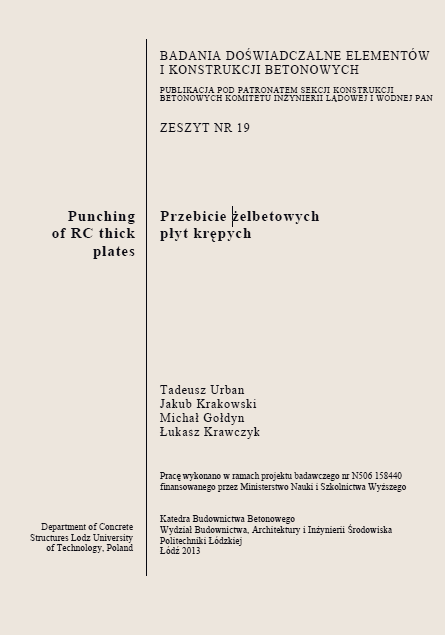Abstract
In calculations of the carrying capacity for punching foundations (of thick plates) a shear slenderness is taking into con-sideration by Eurocode 2 with the help of the additional f(a) = 2d/a function inserted into the basic formula for the limit stresses. This additional element causes the strong increase of the limit stress as the control perimeter u is approaching to the column. A verification of the relations recommended by Eurocode 2 was a main aim of presented tests for calculations of the carrying capacity for punching of foundations and thick plates
As a part of carried out research project there were made and tested three series (altogether 14 pieces) of models of foundation plates in the scale about 1:2, being characterized by small shear slenderness λ ≤ 2. Models had the shape of regular octagons written down into the circle about diameter 1200 mm, with situated in the centre segment of the round column of the diameter 200 mm. Individual models in every series differed in the thickness of the plate which took out 150, 200, 250, 300 and 350 mm. Reinforcement of the models was made from steel of the nominal yield strength fyk = 500 MPa. Individual research series were made from the same concrete mix of the ready-mixed concrete.
Depending on series models differed in the degree of the main reinforcement, like with also forming it.
The first series, counting five models, was characterized by a permanent arrangement and a diameter of the reinforce-ment independently of the elements height what resulted in diversifying of main reinforcement. Part of models with thick-nesses of plate 250, 300 and 350 mm and at the same time the low reinforcement ratio demonstrated the smaller carrying capacity than theoretical, calculated according to principle of Eurocode 2. In the connection with suspicion that the way of examining could to contribute to this fact, in next series the way of anchorage of plates was changed. A stiff steel collar was used, which forced the location of the outlet of the diagonal crack and at the same time its inclination.
In the second series, counting four elements, they were trying to save the permanent ratio of the reinforcement. lndependently of the effective depth d. This purpose was achieved diversifying diameters and the position of the main rein-forcement. In contrast with the first series, additionally a circular reinforcement was used, constraining the deformations in radial direction. At the same time, thanks to the modernization of the way of anchorage, they were forcing with the great accuracy the inclination of punching cone. All research results for these series were above the theoretical curve what can attest to the certain supply of the carrying capacity in the relationship of the Eurocode 2 procedure.
In five models of the third series for which there were a changeable parameters the effective depth d and the ratio of the reinforcement
l, except the highest element in which was only a circumferential reinforcement, experimental results con-firmed appearing of the supply in the carrying capacity for the punching observed in the second series. At the same time they noticed that this phenomenon was appearing independently of the way of the confinement of elements. In all models of these series, similarly as in earlier, radial cracks going through the entire thickness of the plate appeared.
The obtained research results confirmed the correctness of the procedure of calculating the punching shear ca-pacity for thick plates by Eurocode 2, without shear reinforcement. They demonstrated at the same time, that carry-ing capacity of punching of thick plates with the slenderness λ ≤ 2 strongly depends on the level of the confinement of punching zone. Very effective confinement could be obtained by means of circumferential reinforcement.
References
Lavrovich J.S, McLean D.I: Punching Shear Behavior of Slabs with Varying Span-Depth Ratios. ACI Structural Journal, V.87, No 5, September-October 1990, s. 507÷512;
EN 1992-1-1:2004 Design of concrete structures. General rules and rules for buildings.
Talbot A.: Reinforced Concrete Wall Footings and Column Footings. University Of Illinois Bulletin, Vol. X, N. 27, 1913;
Richart F.E.: Reinforced Concrete Wall and Column Footings, Journal of the American Concrete Institute, Vol. 20, 1948;
Dieterle H.: Zur Bemessung quadratischer Stützenfundamente aus Stahlbeton. DAfStb, Heft 387, Berlin, 1987;
Kordina K., Nölting D.: Tragfähigkeit durchstanzgefährdeter Stahlbetonplatten, DAfStb, Heft 371, Berlin, 1986
Hallgren M., Kinnunen S., Nylander B.: Punching shear tests on column footings. Nordic Concrete Research, Stockholm, 1998;
Timm M.: Durchstanzen von Bodenplatten unter rotationsymmetrischer Belastung, DAfStb, Heft 547, Berlin, 2004;
DIN 1045-1, Tragwerke aus Beton, Stahlbeton und Spannbeton. Teil 1: Bemessung und Konstruktion, Juli 2001, Beton Kalender 2002;
Hegger J., Ricker M., Sherif A.G.: Experimental Investigations on Punching Behavior of Reinforced Concrete Footings, ACI Structural Journal, Vol. 103, No. 4, July-August 2006, s. 604-613;
Hegger J., Häusler F., Ricker M.: Zur Durchstanzbemessung von ausmittig beanspruchten Stützen-knote


